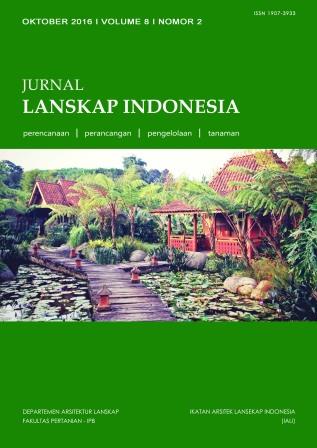MODEL LANSKAP PERMAKULTURA KEBUN PERCOBAAN CIKABAYAN UNTUK MEMENUHI KEBUTUHAN PANGAN BERGIZI MAHASISWA ASRAMA IPB
Abstract
The food quality is determined by the food system, from the food production process, food distribution to food consumption. The production process is related to the agricultural landscape planning. That is the most important step to contribute the production results. Yet, basic knowledge about its benefits values for increasing the potential production are unknown, hence people usually ignore this step planning. Bogor Agricultural University (IPB) as the center of excellence of agricultural science and technology can be a potential sample for application of agricultural planning for production. Thus, the concept of permaculture, which is linked by agricultural productivity based on socio-economic, and ecological has a big chance to be applied. The general objectives of this research were to compose permaculture landscape model and for supply nutritious food needs IPB’s dormitory students. The research surveyed bio-physics potency in Cikabayan campus experimental sites. These estimations are really useful for site analysis of model of permaculture. Result showed the nutritious food needs ingredients for IPB’s dormitory students is 2 299.14 tons from source of plant foods and 406.35 tons from source of animal food which is divided into 18 commodities. The results of agricultural planning with the permaculture landscape model at Cikabayan experimental sites. Results showed that there is a potential production corn 28.43 tons, spinach 10.89 tons, tomato 22.348 tons, kale 6.54 tons, bean 16.44 tons, celery 3.92 tons,and spring onion 5.6 tons. Totally production to supply food needs plant about 94.168 tons. These productions results from Cikabayan experimental sites can supply about food needs plant resources 4.09% for IPB’s dormitory students. This approach could be used by local campus institution to created food self-sufficiency from the assets of land.
Downloads
References
Alcamo J. 2008. The SAS approach: combining qualitative and quantitative knowledge in environmental scenarios. Environmental Futures: The Practice of Environmental Scenario Analysis. Amsterdam, (NED) pp.123–148.
Almatsier S. 2005. Prinsip Dasar Ilmu Gizi. Jakarta (ID) : PT Gramedia Pustaka Utama.
Douglas AL. 2016. Designing agricultural landscape for biodiversity-based ecosystem services. Basic and Applied Ecology Journal. 1 (12) : 3-10.
Gold S.M., 1980. Recreation Planning and Design. New York (US): Mc Graw-Hill Book Company.
Holmgren D. 2006. Permaculture : Solutions for Energy Descent [internet]. [Waktu dan tempat pertemuan tidak diketahui]. Melbourne (AU): Peak Oil and Permaculture Australian Tour Spring. hlm 1-10; [diunduh 2016 Nov 7]. Tersedia pada: https://holmgren.com.au/tag/peak-oil-2/?v=3a1ed7090bfa
Pemerintah Republik Indonesia. 2012. Undang-Undang Republik Indonesia Nomor 18 Tahun 2012 tentang Pangan. Jakarta (ID) : Sekretariat Negara.
Pemerintah Republik Indonesia. 2012. Undang-Undang Nomor 12 Tahun 2012 tentang Pendidikan Tinggi. Jakarta (ID) : Sekretariat Negara.
Setiana A. 2013. Laporan Tahunan University Farm. Bogor (ID): University Farm.
Soekarno PWB. 2011. Pemaparan Rektor IPB pada Acara Rabuan Bersama IPB Tahun 2008-2010. Bogor (ID): IPB Press.
Studer R, Benjamins V, Fensel D. 1998. Knowledge engineering: principles and methods. Data and Knowledge Engineering Journal. Karisruhe (GR): 25 (1) 161–197.
Priandono A. 2007. Perancangan Kebun Produksi Berbasis LEISA untuk Pemenuhan Kebutuhan Gizi Sehat: Kasus Mahasiswa Asrama TPB-IPB [skripsi]. Bogor (ID): Institut Pertanian Bogor.
This journal permits and encourages authors to post items submitted to the journal on personal websites or institutional repositories both prior to and after publication, while providing bibliographic details that credit, if applicable, its publication in this journal. However, after the article is submitted and published in this journal, it is fully copyrighted by the Jurnal Lanskap Indonesia or JLI. If excerpts from other copyrighted works are included, the author must obtain written permission from the copyright owner and give credit to the source in the article. Then, the writer or reader is allowed to copy, share, and redistribute articles/material in any form. But it must still include the appropriate source and credit because the article in this journal is licensed by Creative Commons Attribution 4.0 International License (CC BY 4.0).
I. Proposed Policy for Journals That Offer Open Access
Authors who publish with this journal agree to the following terms:
- Authors retain copyright and grant the journal right of first publication with the work simultaneously licensed under a Creative Commons Attribution License that allows others to share the work with an acknowledgement of the work's authorship and initial publication in this journal.
- Authors are able to enter into separate, additional contractual arrangements for the non-exclusive distribution of the journal's published version of the work (e.g., post it to an institutional repository or publish it in a book), with an acknowledgement of its initial publication in this journal.
- Authors are permitted and encouraged to post their work online (e.g., in institutional repositories or on their website) prior to and during the submission process, as it can lead to productive exchanges, as well as earlier and greater citation of published work (See The Effect of Open Access).
II. Proposed Policy for Journals That Offer Delayed Open Access
Authors who publish with this journal agree to the following terms:
- Authors retain copyright and grant the journal right of first publication, with the work after publication simultaneously licensed under a Creative Commons Attribution License that allows others to share the work with an acknowledgement of the work's authorship and initial publication in this journal.
- Authors are able to enter into separate, additional contractual arrangements for the non-exclusive distribution of the journal's published version of the work (e.g., post it to an institutional repository or publish it in a book), with an acknowledgement of its initial publication in this journal.
- Authors are permitted and encouraged to post their work online (e.g., in institutional repositories or on their website) prior to and during the submission process, as it can lead to productive exchanges, as well as earlier and greater citation of published work (See The Effect of Open Access).



























